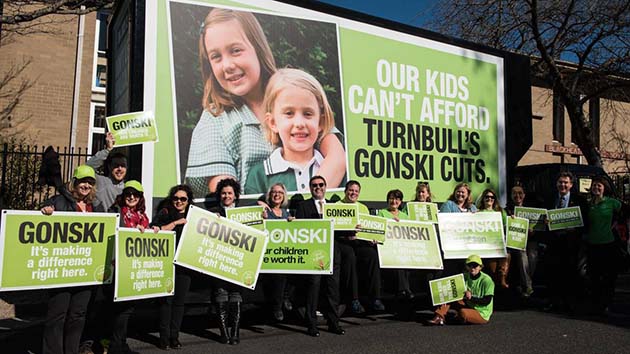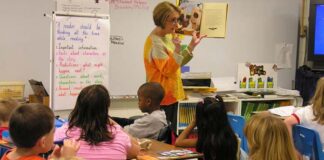The Gonski funding model allows the divide in education to continue, and does not challenge the flawed testing regime, argues Lucy Honan
In November, newspaper headlines screamed about Australian schools sliding down international rankings—but that is not the measure of the real crisis in Australian education.
The Australian school system is now one of the most unequal in the world. Our schools are now more socially stratified than those in Canada, New Zealand or even the UK, and about as unequal as those in the US. And it’s getting worse; government funding to elite private schools has increased at twice the rate of funding to public schools.
Meanwhile nearly 600,000 children live in poverty and public schools are struggling to cater for the majority of them, with vastly inadequate resources.
Public schools in Victoria must scrounge together almost as much money in parent contributions and philanthropic donations as they receive in funding from the Education Department just to run a basic program. Some public school principals have even hired out teachers to private schools to raise funds.
The MySchool league table that encourages parents to shop around instead of enrolling their children at the local public school is exacerbating the inequality, creating deprived, second-class public schools that cater for those students who have no alternative. Former Labor Prime Minister Julia Gillard claims as one of her major achievements.
The Australian billionaire David Gonski’s review into school funding in 2011 was supposed to reverse the inequality.
He proposed a “needs-based” funding formula that was put forward as a way to end dodgy government funding of elite private schools, and the beginning of a transparent flow of increased funds to schools with higher concentrations of Indigenous, low socio-economic status, disabled or geographically isolated students.
But five years later, public school teachers and students are watching some private schools raking in almost triple what they should get according to Gonski’s own formula, whilst public schools still miss out on the basics. In 2014, Loreto Kirribilli (NSW) received 283 per cent of the Schools Resource Standard (SRS), the basic taxpayer funding set for each public school.
The Labor Party and the Australian Education Union are campaigning to push the federal Liberal government to fully fund the final two years of the Gonski agreement. Public education desperately needs more funding, but it is time to admit that the Gonski recommendations were never about reversing school inequality.
Gonski enshrines a rigged funding model that sees private schools keeping their sticky paws in government funding; and entrenches competition between schools for test scores by tying funding to school NAPLAN improvements. It should have been rejected by the teachers’ unions and public education defenders from the outset.
We need a campaign to defend and restore public education led by teachers. Demands for smaller classes, more preparation time, and an end to the destructive competition for test scores need be at the centre of such a campaign.
The extent of inequality
The authors of the Gonski report were disarmingly clear, and obviously a little panicked, about the extent to which the Australian education system is not just replicating social divisions, but compounding them.
On the international education league tables (Program for International Student Assessment, or PISA), Australia was classified as a “low equity country” in 2000, and rose to the level of “average equity” in 2009 but only because students from wealthier backgrounds dropped their performance.
Gonski identified that “compared with other high-performing OECD countries, Australia’s schooling system is characterised by a strong concentration of disadvantaged students in certain schools, and conversely, a strong concentration of advantaged students in other schools. Australia also has a relatively low proportion of students who attend schools with average or mixed socio-economic backgrounds.”
This clumping of kids into “rich” and “poor” schools is a problem because learning is a very social process. The overall socio-economic status of a school has a stronger impact on students’ learning outcomes than the effect of an individual students’ own socio-economic status (SES).
As anyone who has taught at a school serving mainly low SES students can attest, classrooms can become echo chambers of anger, disaffection and disengagement when there is a critical mass of students who come to school already battling the injustice and humiliation of poverty.
Short tempers trip-wire the classroom, and teachers, as emblems of a hostile system, have a hard task convincing students they can offer anything of relevance to their lives. There are not enough inspirational posters and “high expectations” mantras in the world to disguise the demoralising reality that our education system has thrown these students on the scrap-heap of public education.
In schools with a greater mix of wealth, teachers and students are more likely to have better, more relaxed relationships; classes can hold focus for longer, concepts can be explored further. The overall patience of students and teachers is higher, and in such a learning environment the students who most need a calm refuge can sometimes find it, rather than ricocheting exasperation.
Having said that, it is also worth noting that in predominantly rich schools, as opposed to “mixed” and poor schools, poor students are more likely to be excluded and bullied. The mix is important.
These facts are spelled out in the Gonski report. At one level, the declining educational performance measured by PISA is a concern for the ruling class; low education can be drag on productivity. In crude corporate terms, boosting student performance can boost profits and decrease the cost of unemployment.
Gonski (himself a chairman of Coca-Cola Amatil, Transfield, Singapore Airlines, Morgans Stanley and more) quotes economists at KPMG, who calculated that increasing the number of kids with Year 12 attainment would boost GDP by $11.8 billion annually.
Yet as much as Gonski could identify the problem of a ranked education system, his recommendations, even if implemented to the letter, would do nothing to dismantle the policies driving inequality, and could even make it worse.
Funding private schools
There is a spectacular contradiction at the heart of the Gonski recommendations.
On the one hand it was meant to promote a more transparent and “needs-based” funding model that would direct more funding to poorer schools and those with high needs.
On the other hand, Labor Prime Minister Julia Gillard insisted that Gonski also had to honour existing deals with private school “old boys”, headmasters and state governments. So, under Gonski, the government actually grossly over-funds private schools that are already flush with ovals, swimming pools and state-of-the art theatres.
The explicit bias in favour of elite schools could not be more obvious. Gonski does nothing to dismantle the two-tiered structure of government and private schools.
But Gonski’s so-called “needs-based funding” approach is also a problem because it ignores whether a school is private or public. By providing government subsidies to fee-paying schools, Gonski ensures that they play a permanent polarising role. This drives social segregation in the education system even within poorer working class areas.
For example, Catholic schools in working class suburbs can be almost entirely reliant on government funding, yet still demand a small, but important, fee from families that will separate those children from even poorer children in the area.
And above them all, the rich private schools (still government subsidised), as always, take the kids from the richest families.
Competing public schools
Not only has Gonski boosted private schools, his recommendations entrench a market in public education and hasten the disintegration of state public school systems into competing schools.
The increasing use of publicly comparable “performance data” (such as the national literacy and numeracy NAPLAN tests and Year 12 ATAR scores) is driving a deeper hierarchy among public schools.
One very cheap option for reducing inequality in schools would be to ban the MySchool website, which exacerbates social segregation in schools by encouraging parents to compare student scores at different schools and shop for the “best” school they can access (i.e. schools with higher concentrations of wealthier students).
This segregation means some public school principals chase high scores at almost any cost. They will avoid enrolling students with poor academic prospects, and discourage low performers from sitting tests. Or students are pushed out of school into alternative “pathways”.
Some public schools set “compulsory” voluntary school fees that are high enough to send a clear signal to poorer families that they are not welcome.
In short, public schools mimic private school elitism, with attempts to attract students from better-off backgrounds while other local schools absorb the students at the bottom of the pile.
Gonski ordered an expansion of education measurements, so that kids would face more tests on more things. There are more intense “accountability” measures, so that the scrutiny of school and student achievement can become more obsessive.
He gave approval to the kind of school autonomy seen in Victoria, where principals are independent of the education department and allowed to run public schools like their own business, competing for positions on the league tables.
He spent a chapter of his report discussing how public school principals should be taught to raise money from philanthropic charity as a way to give their school a funding edge.
Chasing the data
On top of all this, Gonski shoved the NAPLAN tests and measured performance “outcomes” focus into the centre of the funding formula.
Schools should be funded so they can reach internationally recognised best practice. The government should provide enough funding to drop all class sizes to between 15 and 20 students.
Despite what some bogus educational gurus like Melbourne University’s John Hattie say, there has been solid evidence for decades that a significant decrease in class sizes improves student learning. Yet, Australia’s class sizes are still higher than the OECD average.
There should also be enough funding to increase teacher preparation time to make it comparable to the envied school systems in Finland or Shanghai where teachers have double the preparation time of Victoria.
But under Gonski, funding is based on an “outputs” approach, like the failed American “No Child Left Behind” model.
Under this model, the “School Resource Standard” is set by the bare minimum amount that a reference group of high achieving schools require to get 80 per cent of their students over the NAPLAN line. And this funding does not include money for school buildings and land, extra-curricular or enrichment activities, or health and welfare support!
When private schools can’t raise the money, their budget is topped-up by the government. But public schools are starved of funds.
Extra funds are supposed to go to schools with disadvantaged students, but both the ‘resource standard’ and the extra loadings come with increased ‘accountability measures’ (read, strings) to ensure that any extra the money is used to produce greater “outputs”—i.e. to meet minimum standards according to the test data.
Teachers who have seen the early stages of Gonski money trickle into their schools have complained bitterly because the way the meagre extra dollars are spent is often counter-productive.
Reports abound of wasted professional development sessions with snake-oil consultants who claim their improvement strategies will see a jump in school “outcomes”. Number-crunching consultants are hired to calculate the value that teachers have, or have not, added to student test scores; money is wasted on prescriptive “packages”, often bought from the USA that promise to turn around student performance if teachers submit to the program.
A 2016 principals’ survey found that in schools with Gonski funding, over half of principals were spending their funding on “professional development to improve quality of teaching” compared to only 21 per cent who said they had spent money on employing more teachers to reduce class sizes.
Meanwhile a survey of Victorian teachers this year found that 90 per cent of teachers say that their excessive workload negatively affects the quality of their teaching. Over two-thirds of teachers don’t have enough time to plan their classes to the level that they believe is needed.
Despite the supposed concern about Australian school inequality, the Gonski recommendations actually guarantees inequality and its funding formula adds more demands and more pressure onto teachers, while doing nothing to reduce teaching stress and workloads.
Where are the teachers in Gonski?
The Australian Education Union (AEU, which represents public school teachers and support staff) and its state branches have spent two federal election cycles and countless state elections running entirely uncritical “Give a Gonski” marginal seats campaigns.
Union members were encouraged not to speak of public schools during door-knocks, but of needs-based funding for “all schools”. When members started to bring up the problems with the way early tranches of Gonski money were being spent at their school, and even when federal Liberal Minister Simon Birmingham revealed that Gonski funding would go elite private schools, the union leaders have maintained full, unequivocal Gonski support.
But the relentless, blind support for “the full Gonski” and years of marginal seats’ campaigns have not secured the full funding increase. Ironically, according to AEU polling, public support for Gonski is dropping, because people object to Gonski providing unfair private school funding!
Gonski, a representative of the corporate 1 per cent should not be setting the parameters for public school funding.
An effective public education campaign needs to start with what would actually work to boost real funding and reverse school inequality. Teachers’ demands for decreased workloads, smaller class sizes and ending the race to the bottom set by NAPLAN scores, are essential for ensuring public schools get the money they need.
We have to openly call for an end to government funding for private schools if we are going to stop the social segregation of state schools and students.
There is a deep anger among teachers at the state of our schools and our working conditions. If such demands were at the centre of a public education funding campaign, we would be offering real solutions to the problems of inequality plaguing Australian schools.
The marginal seats campaigns rely on our ability to convince voters to elect Labor politicians. Yet Labor is committed to Gonski, and as we have seen Gonski will not save public education.
The fight for public education needs to start with teachers, and the industrial power that teachers have to fight and win. There would be widespread support for a real campaign to restore public education.
Work bans, strikes, NAPLAN boycotts could create havoc for the already besieged Turnbull government, and make the crisis in our schools a political crisis for the Liberals.






